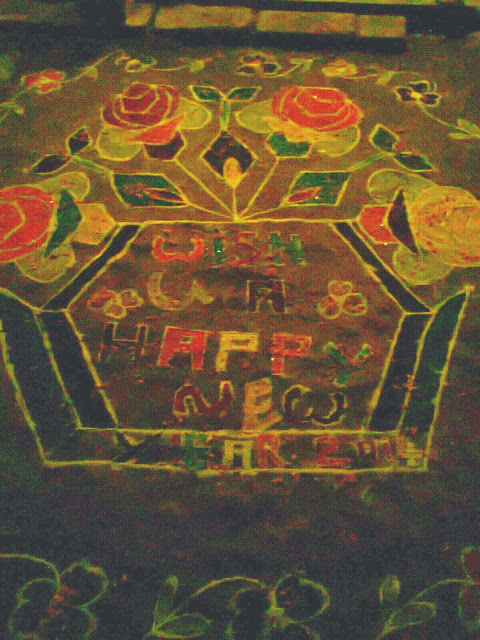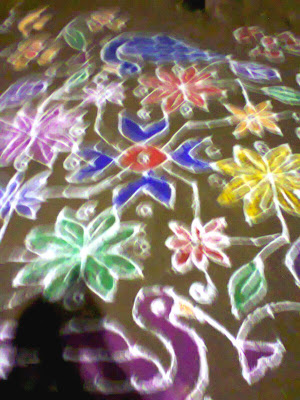This is my first post in the year 2014.Wish You A Happy New Year 2014 to all people.
In this post i am sharing about most beautiful and Incredible Art Patterns of India "Rangoli designs" by starting with a beautiful 2014 Rangoli design.
Rangoli, also known as Kolam or muggu is a Folk Art from India in which patterns are created on the floor in living rooms or courtyards using materials such as colored rice, dry flour, colored sand or flower petals. It is usually made during Diwali, Onam, Pongal and other Indian festivals. They are meant to be sacred welcoming areas for the Hindu deities. The ancient symbols have been passed down through the ages, from each generation to the next, keeping both the art form and the tradition alive. Similar practices are followed in different Indian states: Muggulu in Andhra Pradesh; Kolam in Tamil Nadu; Mandana in Rajasthan; Chowkpurna in Northern India; Alpana in West Bengal; Aripana in Bihar; Chowk Pujan in Uttar Pradesh; and others.
In this post i am sharing about most beautiful and Incredible Art Patterns of India "Rangoli designs" by starting with a beautiful 2014 Rangoli design.
Rangoli, also known as Kolam or muggu is a Folk Art from India in which patterns are created on the floor in living rooms or courtyards using materials such as colored rice, dry flour, colored sand or flower petals. It is usually made during Diwali, Onam, Pongal and other Indian festivals. They are meant to be sacred welcoming areas for the Hindu deities. The ancient symbols have been passed down through the ages, from each generation to the next, keeping both the art form and the tradition alive. Similar practices are followed in different Indian states: Muggulu in Andhra Pradesh; Kolam in Tamil Nadu; Mandana in Rajasthan; Chowkpurna in Northern India; Alpana in West Bengal; Aripana in Bihar; Chowk Pujan in Uttar Pradesh; and others.
The purpose of rangoli is decoration, and it is thought to bring good luck. Design depictions may also vary as they reflect traditions, folklore and practices that are unique to each area. It is traditionally done by women. Generally, this practice is showcased during occasions such as festivals, auspicious observances, marriage celebrations and other similar milestones and gatherings.
Rangoli designs can be simple geometric shapes, deity impressions, or flower and petal shapes (appropriate for the given celebrations), but they can also be very elaborate designs crafted by numerous people. The base material is usually dry or wet granulated rice or dry flour, to which sindoor (vermilion), haldi (turmeric) and other natural colors can be added. Chemical colors are a modern variation. Other materials include colored sand and even flowers and petals, as in the case of flower rangolis.
Rangoli is an Indian sandpainted design often seen in Diwali, the Indian festival of lights. Rangoli can be any size and can use a wide variety of materials. You can approach Rangoli as an advanced art project for an experienced artist, or modify it for a fun activity with kids.
Rangoli in India belong to any province, the folk art, so its elements are taken from the public are common. Rangoli's most important element is Utswdhermita. For this, auspicious symbols are selected. Thus the symbol for generations as they are made - and is required to make these symbols. Traditionally, each new generation learns the art and thus a family keeps the tradition intact. Some major symbols used in Rangoli are the lotus flower, its leaves, mango, Tue vase, fish, different kind of birds like parrots, swans, peacocks, and human figures and foliage. Oftentimes Rangooli are made on special occasions like Diwali. Some special patterns for Diwali Rangoli are the Deep, Ganesha or Lakshmi.
The second key element is using rangoli incoming material. The same material is used which is easily found everywhere. Therefore this art rich - poor is prevalent in all homes. Normally the major ingredients used to make rangoli - Pise rice solution, dried powder made from the leaves color, charcoal, burned soil was, wood sawdust, etc.. Rangoli is the third important element background. Rangoli for the background was clear floor or wall or Llype is used. Rangoli yard in the middle, corners, or as Bell is created around. Dehri gateway on the tradition of making rangoli. God's seat, depending on lamp, place of worship and sacrifice on the altar is the tradition of decorating rangoli. With time, imagination and innovative ideas in Rangoli art is also incorporated. Hospitality and tourism has also had its effect and it has been commercially developed. The colors also convenient because it places such as hotels is being built on its traditional charm, artistry and importance are still remain.
The above text on Rangoli from the wikipedia website http://en.wikipedia.org/wiki/Rangoli
These are beautiful Rangoli designs which drawn by several woman in front of their houses in our locality on the midnight of 31st December 2013 by saying good bye to the year 2013 and welcoming to the New Year 2014.
This is a Divine pattern Rangoli we draw in front of our house on Diwali celebrations.
These are some Sankranthi (Pongal) special Rangolis. I am using them from Mrs.Sravani Gopal's blog with her permission.
In Andhra Pradesh we celebrated Pongal festival as Makara Sankranthi which is a 3 days festival Boghi, Makara Sankranthi and Kanuma festivals.
This is Pongali Kumbam and Cheraku (Sugarcane) pattern.
This is Haridas pattern. Haridas goes to all houses early in the morning and singing Lord Vishnu's songs.
This is Gangireddu pattern.
Gangireddu: Some oxes are decorates with colourful garments and garlands. Their trainers make them to do some stunts to impress us.
This is complete Sankranthi (Pongal) special Rangoli.















































































Very good collection of pics. Happy Pongal
ReplyDeletewow! very nice collection.
ReplyDeleteGreat information packed post!
ReplyDeleteLovely designs.
Hi Mr Srinivasu..wishing you a very happy new year and happy pongal. I really appreciate your posts because they are packed with information. But what I like the most is your vintage related post.So keep them coming and have a wonderful day!
ReplyDeleteHello Dear Mr. Dokka Srinivas, Every year brings new Colours, New Designs to our Samkranti and New Year and we all bless you, your family and for this remarkable work you are doing. Mantha V Sharma
ReplyDeleteV.ery attractive and good collection of Rangoli. Very common all over India,Looks
ReplyDeletebeautiful ,
Very nice and beautiful Rangolis.
ReplyDeletenice...
ReplyDeleteThank you for the most valuable information. keep it up for good postings................Vedic Architects & Sculptors is the leading the Hindu temple builder specializing in Vastu science for contemporary buildings, Temple Vigraham in Stone and Stone carving architecture in Chennai.
ReplyDeleteStone Carving Architecture In Chennai
Happened across your article while searching via yahoo. I understand the very first paragraph and its great!
ReplyDeleteLiquid Sindoor raw materials
ReplyDeleteIt is very needful blog for every travelers please read.Heritage Holidays in India
Useful Information, your blog is sharing unique information.
ReplyDeleteDecorated Pooja Thali
Thanks for sharing this...good blog
ReplyDeletehttps://www.glassdoor.com/Reviews/Employee-Review-Fluper-RVW15043091.htm
https://www.glassdoor.com/Reviews/Employee-Review-Fluper-RVW15043091.htm
https://www.glassdoor.com/Reviews/Employee-Review-Fluper-RVW15043091.htm
https://www.glassdoor.com/Reviews/Employee-Review-Fluper-RVW15043091.htm
https://www.glassdoor.com/Reviews/Employee-Review-Fluper-RVW15043091.htm
https://www.glassdoor.com/Reviews/Employee-Review-Fluper-RVW15043091.htm
even i love making different Rangoli designs for Diwali. and i am trying something different for every year. that's why i am worried about this year because i have nothing for this Diwali. but i found what i want .thanks!
ReplyDeleteHow To Collect Rangoli Stamp - https://tech4hax.com/how-to-collect-rangoli-stamp/
ReplyDelete